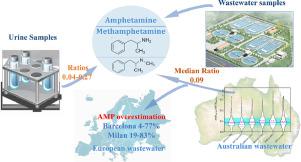Water Research ( IF 12.8 ) Pub Date : 2022-09-28 , DOI: 10.1016/j.watres.2022.119182 Jianfa Gao 1 , Daniel A Burgard 2 , Benjamin J Tscharke 3 , Foon Yin Lai 4 , Jake W O'Brien 3 , Hien D Nguyen 5 , Qiuda Zheng 3 , Jiaying Li 3 , Peng Du 6 , Xiqing Li 7 , Degao Wang 8 , Sara Castiglioni 9 , Copytzy Cruz-Cruz 10 , Jose Antonio Baz-Lomba 11 , Viviane Yargeau 12 , Erik Emke 13 , Kevin V Thomas 3 , Jochen F Mueller 3 , Phong K Thai 3

|
Consumption of amphetamine and methamphetamine, two common illicit drugs, has been monitored by wastewater-based epidemiology (WBE) in many countries over the past decade. There is potential for the estimated amount of amphetamine used to be skewed at locations where methamphetamine is also consumed, because amphetamine is also excreted to wastewater following methamphetamine consumption. The present study aims to review the available data in the literature to identify an average ratio of amphetamine/methamphetamine (AMP/METH) that is excreted to wastewater after methamphetamine consumption. This ratio could then be used to refine the estimation of amphetamine consumption in catchments where there is both amphetamine and methamphetamine use. Using data from more than 6000 wastewater samples from Australia where methamphetamine is the dominant illicit amphetamine-type substance on the market, we were able to subtract the contribution of legal sources of amphetamine contribution and obtain the median AMP/METH ratio in wastewater of 0.09. Using this value, the amphetamine derived from methamphetamine consumption can be calculated and subtracted from the total amphetamine mass loads in wastewater samples. Without considering the contribution of amphetamine from methamphetamine use, selected European catchments with comparable consumption of amphetamine and methamphetamine showed up to 83% overestimation of amphetamine use. For catchments with AMP/METH ratio greater than 1.00, the impact of amphetamine from methamphetamine would be negligible; for catchments with AMP/METH ratio in the range of 0.04-0.19, it will be difficult to accurately estimate amphetamine consumption.
中文翻译:

通过基于废水的流行病学改进苯丙胺消费量的估计
在过去十年中,许多国家都通过基于废水的流行病学 (WBE) 监测两种常见非法药物苯丙胺和甲基苯丙胺的消费情况。在甲基苯丙胺也被消费的地方,苯丙胺的估计数量可能会有所偏差,因为苯丙胺在消费甲基苯丙胺后也会排泄到废水中。本研究旨在审查文献中的可用数据,以确定食用甲基苯丙胺后排泄到废水中的苯丙胺/甲基苯丙胺 (AMP/METH) 的平均比率。然后可以使用该比率来改进同时使用苯丙胺和甲基苯丙胺的集水区中苯丙胺消费量的估计。使用来自澳大利亚的 6000 多个废水样本的数据,其中甲基苯丙胺是市场上主要的非法苯丙胺类物质,我们能够减去合法来源的苯丙胺贡献,并获得废水中 AMP/METH 比率的中位数为 0.09。使用此值,可以计算出甲基苯丙胺消耗量产生的苯丙胺,并从废水样品中的总苯丙胺质量负荷中减去。在不考虑甲基苯丙胺使用对苯丙胺的贡献的情况下,选定的具有可比苯丙胺和甲基苯丙胺消费量的欧洲集水区显示出高达 83% 的苯丙胺使用高估。对于 AMP/METH 比率大于 1.00 的集水区,来自甲基苯丙胺的苯丙胺的影响可以忽略不计;


























 京公网安备 11010802027423号
京公网安备 11010802027423号